The Amateur Mycologist #17 - Auricularia auricula - The Jelly Ear Mushroom
These posts are not for foraging. They are intended for entertainment and intellectual satisfaction only. These posts are not a field guide nor comprehensive in any way - their accuracy is not assured in any way. Do not eat wild mushrooms unless you are a professional, have substantial professional assistance or have a wealth of personal experience with a specific species. Do not make any foraging decisions based on these posts. To do so could be dangerous or life threatening.
These Posts Contains No Information Regarding Edibility Or Toxicity
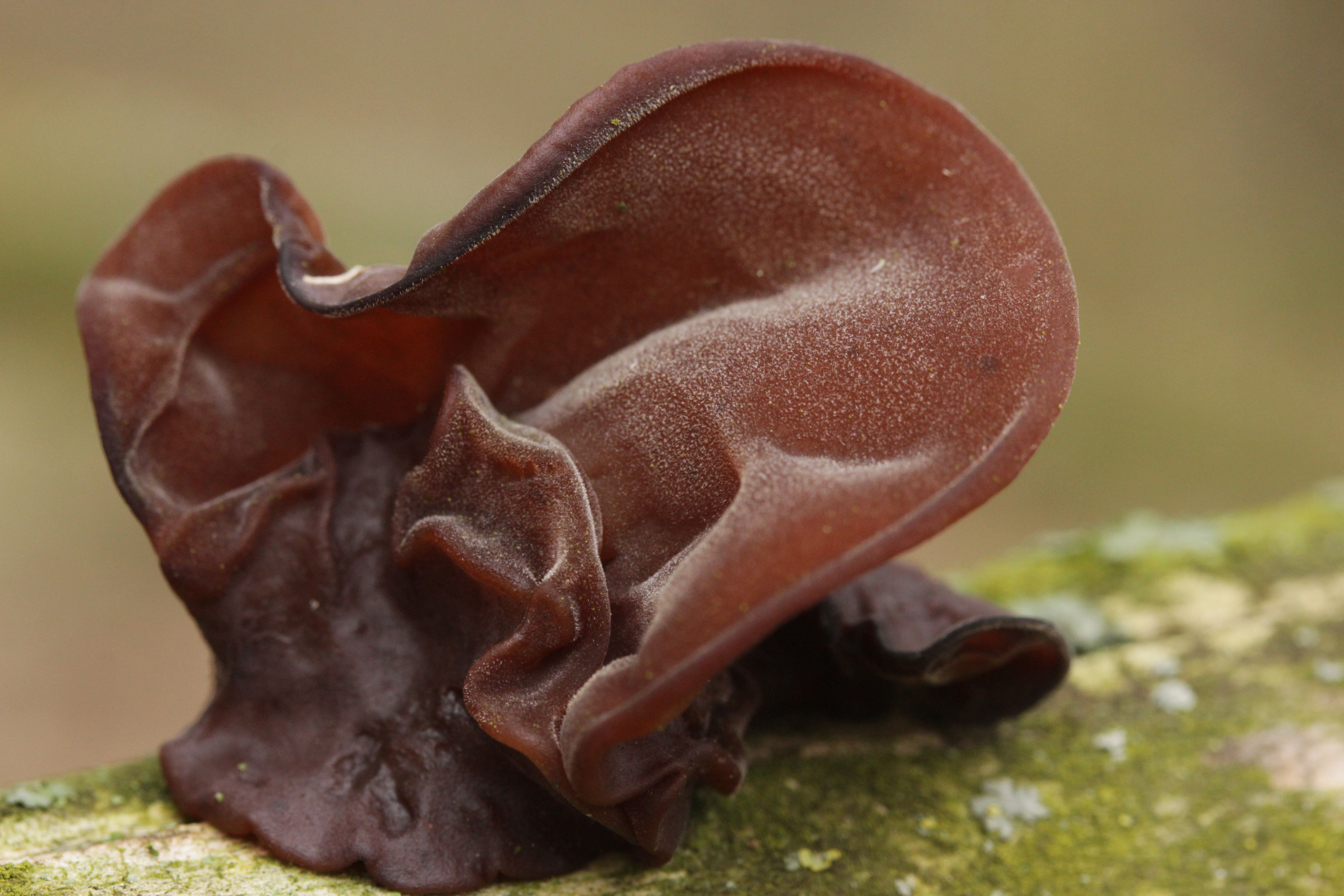
Had Nature any supple Face
Or could she one contemn —
Had Nature an Apostate —
That Mushroom — it is Him!
Emily Dickenson was inspired to poetry by the bizarreness that it A.auricula, or the Jelly Ear.
The Jelly Ear is a strange little mushroom. First and foremost, it really does look like an ear, right? I mean, a bizarre ear growing out of a dead elder tree or other hardwood, but an ear nonetheless.
Actually, not every A.auricula specimen looks so convincingly ear-like, especially if the mushrooms are growing in a shelf-like format, where their spore surface aims downward at the ground rather than sprouting upwards from a fallen log.
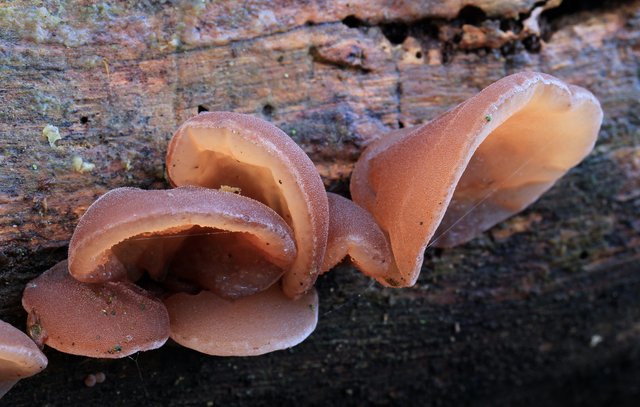
Although the nickname "Jelly Ear" appears to be totally appropriate, it is a relatively new rebranding. For many years, unfortunately, A.auricula was also known as the "Jew's Ear." There are conflicting stories about why this was the case.
One narrative is that the name stems from the relationship of the mushroom to the Elder tree, which was the same kind of tree from which the biblical Judas allegedly hung himself after betraying Jesus Christ. This theory gains some support by the alternative scientific name for the species, also accepted by some, A.auricula-judae. Under this interpretation, the nickname "Jew's Ear" is less an antisemitic reference and more a reference to Judas the individual.
Michael Kuo implies that he disagrees with this interpretation, as do I. Personally, I think it's just a backward, antisemitic nickname that survived through the ages, as such things are wont to do. Therefore, I don't use either the nickname, nor the "judae" addendum on the scientific name.
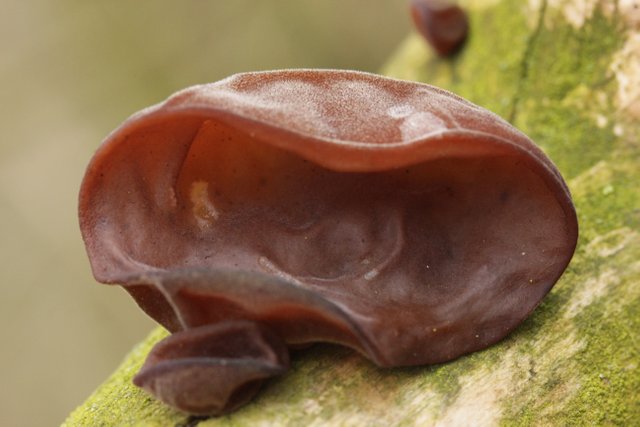
Jelly Ears look very different from many other mushrooms. They do not have stems, exactly, just a piece of flesh attached to the wood. They grow exclusive on decaying wood - perhaps with a specific love for Elder trees.
They usually grow in groups, either all coming from the same attachment point or each attached separately. The "Jelly" trait is no joke - the mushrooms look and feel like jelly! They have a gelatinous and rubbery texture, especially when young and not too dry or deteriorated.
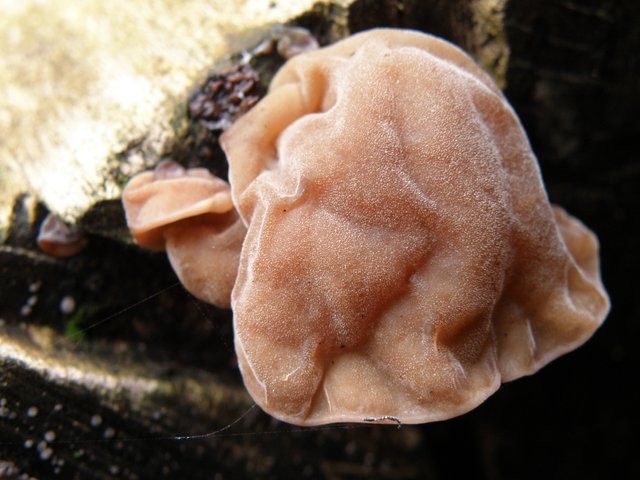
The top of A.auricula can have a bunch of different traits.
In this picture, it's a light brown, almost flesh-toned, with wrinkled flesh covered in a very fine down that would be soft to the touch, like tiny fur.
But compare that to the picture below:
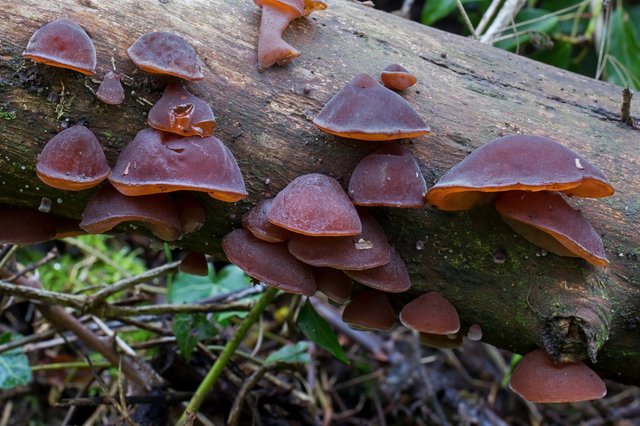
These are also A.auricula specimens. But they look quite different.
The color is much darker and the skin less downy, covered in much smaller, less prominent dots.
Although they look somewhat strange, Jelly Ears are in the same Division of the Fungi Kingdom, Basidiomycota, as most of the species we've talked about. They reproduce sexually through the dispersal of spores from a spore surface.
Take a look at the pictures above showing the underside of the Jelly Ears. That is the spore surface. And like the spore surface of any mushroom, it is releasing spores almost constantly from maturity until death. In fact, since dehydration is the norm for mushrooms, the spore surface is capable of dispersing spores even at near complete water loss, after the mushroom is totally desiccated.
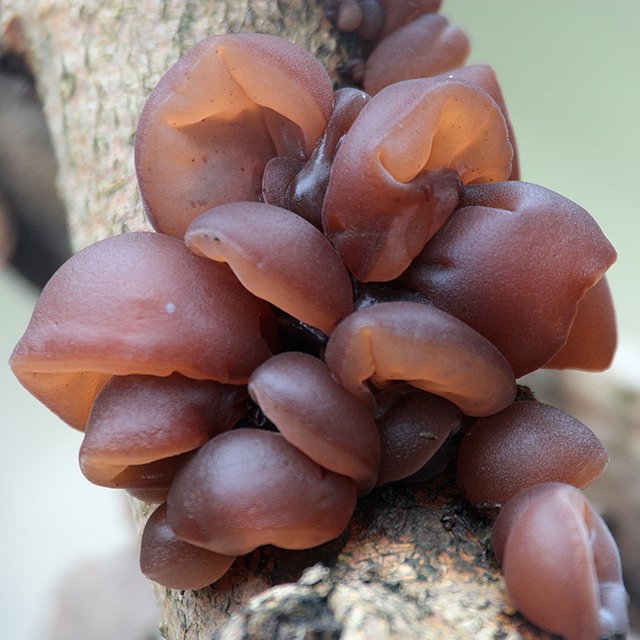
One last weird thing
You'll remember that many of the other mushrooms we've highlighted were thrown into a state of taxonomic confusion by the advent of DNA analysis. From what I can tell, the Jelly Ear has suffered no such fate. However, I find this genetic homogeneity unlikely given the ubiquity of the mushroom globally and the genetic diversity found throughout the Kingdom. Could be wrong, but I think either I missed something or widespread DNA analysis has not yet been done.
Whatever the case may be, keep your eyes peeled for these oddballs growing in many of the worlds deciduous and coniferous forests, in almost all seasons.
Macroscopic Features
- Cap/Flesh = ranging in size between 2-15 cm, with an average of around 3 to 8 cm across. The "ear" analogy works much of the time, but not always. Sometimes cup shaped, either facing down or upwards. Color of the cap ranges from light brown/tan to dark brown. The actual flesh is gelatinous, but not like a jello mold, more like a jelly bear. The top of the cap can be anywhere from downright downy to slightly furry.
Spore surface = Pores are not visible to the naked eye, like normal polypores. The pore surface is, usually, lighter than the cap, with a similarly gelatinous texture and similar color range.
Stem ("stipe") = Generally no stem, in a conventional sense. Usually just attached directly to a piece of decaying hardwood, and growing from that attachment. Sometimes that attachment may become a bit long, and so then it can look like a stem.
- Spore Print = White and collectible as with most normal members of Basidiomycota division.
Ecology ("How it grows.") = Saprobic - grows exclusively on decaying hard wood trees, with a possible affection for Elder trees in particular.
Distribution = All over the world, from spring through winter sometimes.
Other Traits = I didn't see any confounding taxonomic DNA information available, but some certainly may exist.
THIS POST IS NOT INTENDED FOR FORAGING PURPOSES AND TO USE IT FOR THOSE PURPOSES WOULD BE DANGEROUS. DO NOT HUNT WILD MUSHROOMS WITHOUT RELYING ON A COMBINATION OF PROFESSIONAL FIELD GUIDES, IN PERSON PROFESSIONAL GUIDANCE, OR IN PERSON GUIDANCE BY SOMEONE TRUSTWORTHY WHO HAS COPIOUS LOCAL, SPECIALIZED MUSHROOM HUNTING EXPERIENCE. FAILURE TO DO SO CAN RESULT IN GRIEVOUS PERSONAL HARM OR DEATH.
Support the SteemSTEM project - curating and encouraging quality STEM related content across the STEEMIT platform
Information Sources:
The Mushroom is the Elf of Plants, Emily Dickenson
http://www.mushroomexpert.com/auricularia_auricula.html
https://en.wikipedia.org/wiki/Auricularia_auricula-judae
http://botit.botany.wisc.edu/toms_fungi/apr2004.html
Photo Sources:
[1][By Björn S... (Auricularia auricula) CC BY-SA 2.0, via Wikimedia Commons
[2]Stu's Images CC BY-SA 3.0, via Wikimedia Commons
[3]By Björn Sothmann (Own work) CC BY-SA 4.0, via Wikimedia Commons
[5]Stu's Images CC BY-SA 3.0, via Wikimedia Commons
[6]By Jerzy Strzelecki (Own work) CC BY-SA 3.0 via Wikimedia Commons
I must admit, I don't know a lot about mushrooms, but they have recently been catching my eye. I have challenged myself to a personal photo-a-day challenge, and I have found that the camera brings out a lot of hidden beauty in mushrooms. Now, I want to learn more! I saw this article resteemed by @fabulousfungi, and I'm glad I checked it out. Following in hopes that I can learn more!
Would you mind checking out a post and giving me some advice on what features I need to focus on to help identify fungi? I took photos and tested a few things that I've read about, but I'm not sure that they are sufficient. The post is https://steemit.com/nature/@sustainablyyours/daily-photo-shoot-8-18-17-a-mushroom-patch. Any advice you have is much appreciated!
Hey - i read your post and I really appreciate that you're coming at the process in a detail oriented and respectfully circumspect way.
I'm going to say here what I say first now in all my posts - I don't advise anyone to forage wild mushrooms for food without consulting with local experts. I think you should google the nearest mycological society and/or meetup - and try to go hunting with them. IMO that is the only way to really be confident and feel safe doing it alone eventually.
Having said that, ID'ing for non-foraging purposes is a ton of fun for me and others and I think learning to do that is great hobby. Plus with your camera skills it can help to create Steemit content that is both pretty, informative, and responsible.
You already have a great eye for detail, even knowing to look for latex for example or the nearby environment. Some other factors to consider might be smell of the mushroom, a cross section of the stem to check for hollowness, or the changing of flesh or gill color after damaging. There are also several reagents sold online whch react with certain mushrooms in certain ways and for some mushrooms those reactions can be centrally important in getting to a species. Lastly, A spore print is often very important.
With the ones in your post, going back to see what those mushrooms look like when they deteriorate would also be telling. One of the larger ones appears to have a slight darkening on the edge of its cap which could be the start of deliquescence - or auto digestion. That would place you pretty squarely in the Coprinus genus. In terms of getting it down to which species, that's harder. I think maybe the species you found online seems to have caps that are a bit darker than the ones you found.
Unfortunately the details you need to look for for definitive identification change from species to species. You can try mushroomexpert.com and see if he has a key for coprinus species - then you can run thw characteristics of these mushrooms through that key and see what it "keys out" to.
For many species ambiguity is the norm - and it often becomes a game of precentages - i.e. based on X characteristics this is either species A or B - and I'm leaning towards B because of Y.
If you want to take it to the next level of accuracy you should buy some mushro field guides eithr specific to your region to even to a particular genus - and buy an inexpensive mucroscope - then you can start to examine spore structurez as well - which for some mushrooms, like many lactarius for instance, can also be important.
All of which is to say the rabbit hole, even for an amatuer, goes deep if you want it to. For my purposes, I stay relatively shallow, which is part of the reason I don't eat my finds. :).
Don't worry! I am not going to eat anything I find on my own, but I certainly like the suggestion of going out with a local mycological society. I didn't even know there was such a thing. That is a ton of information! I really appreciate you taking the time for such a detailed reply. You provided several resources and ideas that I will definitely check out, and gave me some new things to look for when gathering data in my attempts to identify what I have.
Sorry about spelling - on my phone :)
Upvoted and Resteemed by xx-votesplus, the dropAhead curation team!
Do you want more earnings?
By doing things above you will give us more STEEM POWER (SP) to give you more earnings.
Keep up the good work!
Most recent post: It is official, WE are witnesses!
Very interesting post! I ate these all the time growing up (I'm Chinese) and I didn't know very much about them at all. Good article, keep it up!
Thanks for reading - much more to come
Ha! That's definitely the weirdest looking mushroom I have seen. Loved your post :D
Oh, that's positively normal compared to some of the other doozies out there - some of the earthstars get...strange :)
Great article as always! I really enjoy reading it, and I have to say that sadly, I agree with your interpretation of the addendum "judae".
Upvoted and resteemed!
Thank you! And yeah, as far as the non offensive explanations for the addendum -i ain't buying it it.
Wow I did not even know such things exists - This is very interesting. Resteeming
Thats great - exactly why I write them!
@originalworks
@OriginalWorks Mention Bot activated by @fabulousfungi. The @OriginalWorks bot has determined this post by @dber to be original material and upvoted it!
Do you like what @OriginalWorks is doing? Give it an upvote!
To call @OriginalWorks, simply reply to any post with @originalworks or !originalworks in your message!
For more information, Click Here!
Congratulations! This post has been upvoted from the communal account, @minnowsupport, by DBER from the Minnow Support Project. It's a witness project run by aggroed, ausbitbank, teamsteem, theprophet0, someguy123, neoxian, followbtcnews/crimsonclad, and netuoso. The goal is to help Steemit grow by supporting Minnows and creating a social network. Please find us in the Peace, Abundance, and Liberty Network (PALnet) Discord Channel. It's a completely public and open space to all members of the Steemit community who voluntarily choose to be there.
This post has received a 1.04 % upvote from @drotto thanks to: @banjo.